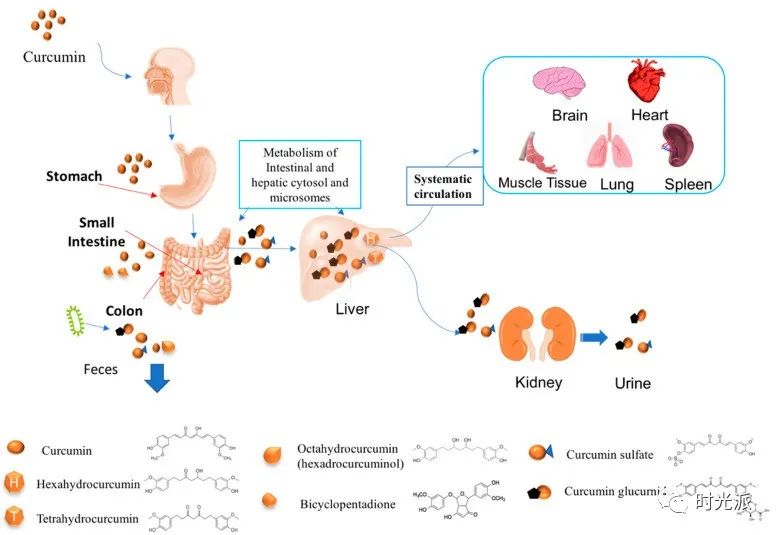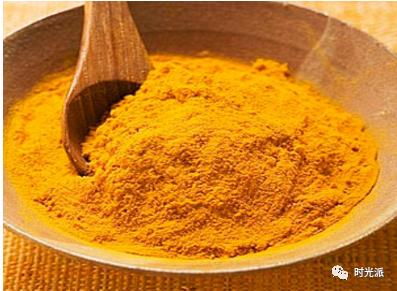Is curcumin, the "new star" of anti-aging, a complete scam?
Original Time School Research Institute Time School is included in the topic # 56 anti-aging substances.
editorial comment/note
Curcumin, which is a’ youth medicine’ and a delicious food, has always had its own place in the anti-aging circle, but it is safe and has no toxic and side effects, but it has not yet been among the top anti-aging products. If you want to listen carefully to the reasons, let’s start with the story of curcumin. ……
Last time, we talked about that a large number of cellular, molecular and clinical studies have proved that curcumin has multiple effects such as anti-inflammatory, anti-oxidation, anti-cancer and anti-microbial (click Review:), but why hasn’t curcumin been licensed and can’t it play a higher role in disease treatment?
Look at people by their character, and look at chemicals by their physical and chemical properties. First of all, we should grasp two characteristics of curcumin: low solubility and unstable chemical properties. Remember these two clues, and the following stories are based on them ~
Low solubility
There is a large hydrophobic region in the molecular structure of curcumin, which determines its basic characteristics of low water solubility. However, there are three hydroxyl groups in its molecular structure, so when the alkalinity is high enough, the charged hydrogen ions will be dissociated, and the curcumin molecule will also be negatively charged, and the water solubility will increase [1]. To put it simply, it is insoluble in water, and the more alkaline it is, the more soluble it is.
instability
Curcumin is a difficult master, and it will change when the environment is a little unsatisfactory. As mentioned above, the greater the alkalinity of the solution, the more curcumin is dissolved, which provides great convenience for the hydrolysis reaction; In addition, curcumin is also easy to occur in the presence of light; What’s more, curcumin may spontaneously oxidize when there is no stimulus! Although so many degradation products have more or less anti-inflammatory and anti-cancer effects, the "periphery" is not as powerful as the "main body" [2].
Then we need to know what curcumin has experienced from eating to discharging, as shown in the following figure [3]:

There are three paths for curcumin to enter digestive tract.
1. In the original form, excreted by feces, jump to the ending 1.
2. After being metabolized by enzymes in digestive tract, it is excreted by feces in the form of metabolites, and jumps to the end 1.
3. Escaped from the clutches of digestive tract enzymes, successfully approached intestinal epithelial cells and entered path B.
There are two ways for curcumin to get close to intestinal epithelial cells.
1. Thrown back to the intestine by the ruthless porters of intestinal epithelial cells, and returned to the path A.
2. Being sent into the blood circulation by the friendly porters of intestinal epithelial cells and entering the path C.
There are two ways for curcumin to reach the liver after it enters the blood circulation.
1. It is metabolized by enzymes in the liver and enters the systemic blood circulation in the form of metabolites, and enters the path D.
2. Escaped from the clutches of liver enzymes, and entered the systemic blood circulation in its original form, and also entered the path D.
After curcumin or its metabolites enter the systemic blood circulation, there are two paths.
1. Enter the kidney with blood, then enter the urine, and pass out of the body with urine, and jump to the end 2.
2. With the distribution of blood to various organs and tissues of the whole body (such as brain, lung, heart, muscle, etc.), it plays an anti-inflammatory, anti-oxidation and anti-cancer role, and jumps to the ending 3.
Obviously, we have high hopes for the ending 3, but how many "difficulties and dangers" does curcumin have to go through to get on this right path? And don’t forget curcumin’s bad temper (low solubility and low stability), so it is even more difficult for it to "survive" success. Therefore, scientists have developed a lot of equipment for curcumin in order to help it succeed.
The role played by these equipments can be summarized as two aspects:
On the one hand, it improves its basic performance (increasing solubility and stability), and on the other hand, it specifically resists "enemy" forces (such as antagonistic cell efflux transporters). The following table is a summary of various methods and principles to improve the absorption and utilization rate of curcumin [3]:
Method type
give an example
principle
Control environmental conditions
Use organic solvents
Increase solubility
Adjust pH
Increase stability
Combined adjuvant
Piperine, catechin, etc.
Inhibition of efflux transporter
Antioxidants such as ascorbic acid and gallic acid.
Increase stability and reduce oxidative degradation.
Packaging technology/carrier technology
Micellar, microemulsion, hydrophobic biopolymer particles, liposomes, etc.
Increase dispersibility in water; Isolate water phase to increase stability; Increase the affinity with tissues and cells
In the research of pushing curcumin into clinical application, the obstacles encountered are not only the above physical and chemical characteristics and biological characteristics of curcumin, but also the research itself:
First of all, curcumin used in various studies is actually different. Most crude extracts made from turmeric and even some refined "curcumin" raw materials contain three main compounds: curcumin, demethoxycurcumin and bis-demethoxycurcumin, and a few secondary metabolites.
The ratio of curcumin compounds in various "curcumin preparations" is different, and the types of curcumin compounds used in experimental research are also different (pure curcumin is often used in in vitro research and more is artificially synthesized, while the mixture of curcumin compounds is often used in in in vivo research and clinical trials), but curcumin is often used as the active ingredient to evaluate the efficacy. In addition, the dosage form and dosage of curcumin used in each experiment are also different. Therefore, it is difficult to compare the effects of curcumin between different studies, and it is difficult to get a consistent conclusion [5].
///
On the other hand, curcumin is a pan-screening interfering compound, which makes it difficult for researchers to judge whether curcumin plays a role in a certain target.
The so-called pan-screening interfering compounds mean that they do not act on the target target but present a sharply confusing false positive result.
Real drugs can precisely act on specific protein binding sites, thus inhibiting or activating the function of protein. The "false positive compounds" are disguised as drug combinations, and smoke bombs are released in various screening studies. Moreover, curcumin does have a wide range of biological activities, just like an all-round sports fan who can win an excellent participation award in various competitions. Therefore, it is not a simple matter to judge whether curcumin has played a valuable role in some way and can be detected correctly [5].
With this explanation, it seems that curcumin is still far from being used as medicine, but there is no need to worry. The above problems are what scientists are trying to solve.

Last time, I made it clear that clinical studies show that taking curcumin up to 12g per day has no side effects, and the FDA also lists curcumin as a recognized safe food additive. We often eat curry, which is healthy and delicious. Isn’t it delicious? As a dietary supplement, curcumin products can also be eaten.
The following summarizes some kinds of turmeric derivatives in life and their uses [6]:
kind
character
use
Curcuma rhizome (intact)
Orange-brown rhizome (dry)
medicinal
Turmeric powder
Red and yellow powder, made by grinding dried rhizome.
Medicine, spices, dyes, dietary supplements
Turmeric resin
Brown viscous liquid, extracted from roots or leaves.
Medicinal, food colorants, dietary supplements
Ginger butter
Brown oil, extracted from roots or leaves.
Medicine, spices, dietary supplements
Curcumin
Orange-red crystalline powder, extracted and purified from turmeric powder.
Medicinal and dietary supplements
Once again, the content of this article is not used to persuade people to quit. We are just adhering to the consistent style, putting facts and being reasonable! Curry tastes good, so can curcumin ~
references
[1] Bernabé-Pineda M., Ram?rez-Silva M.a.T., Romero-Romo M., González-Vergara E., Rojas-Hernández A. Determination of acidity constants of curcumin in aqueous solution and apparent rate constant of its decomposition. Spectrochim. Acta Part A Mol. Biomol. Spectrosc. 2004; 60:1091–1097. doi: 10.1016/S1386-1425(03)00342-1.
[2] Priyadarsini KI. The chemistry of curcumin: from extraction to therapeutic agent. Molecules. 2014; 19(12):20091-20112. Published 2014 Dec 1. doi:10.3390/molecules191220091
[3] Zheng B, McClements DJ. Formulation of More Efficacious Curcumin Delivery Systems Using Colloid Science: Enhanced Solubility, Stability, and Bioavailability. Molecules. 2020; 25(12):2791. Published 2020 Jun 17. doi:10.3390/molecules25122791
[4] Xie Tao, Du Guanhua. The pain of Qualcomm’s quantitative screening —— Pan-active screening interfering compounds [J]. Journal of Pharmacy, 2015(08):925-930.
[5] Nelson KM, Dahlin JL, Bisson J, Graham J, Pauli GF, Walters MA. The Essential Medicinal Chemistry of Curcumin. J Med Chem. 2017; 60(5):1620-1637. doi:10.1021/acs.jmedchem.6b00975
[6] Li S., Yuan W., Deng G., Wang P., Yang P., Aggarwal B. B. Chemical composition and product quality control of turmeric (Curcuma longa L.) Pharmaceutical Crops. 2011; 2(1)
If you have any doubts, ideas, or problems in the field of anti-aging, welcome to discuss them in the comment area!
Original title: "Anti-cancer is short, life expectancy is insufficient, and the anti-aging" new star "curcumin is a complete scam? ! 》
Read the original text